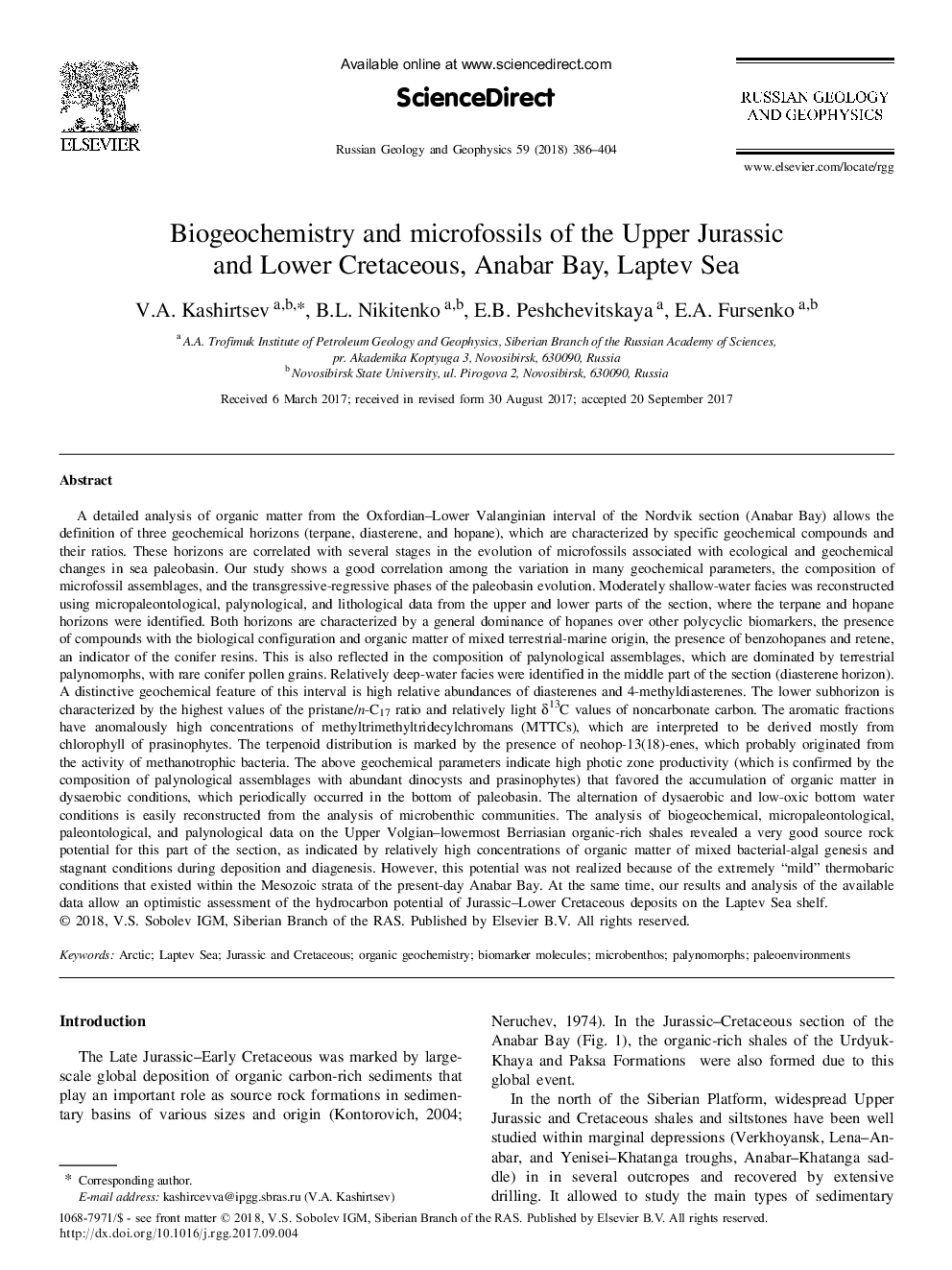| کد مقاله | کد نشریه | سال انتشار | مقاله انگلیسی | نسخه تمام متن |
|---|---|---|---|---|
| 8915190 | 1641035 | 2018 | 19 صفحه PDF | دانلود رایگان |
عنوان انگلیسی مقاله ISI
Biogeochemistry and microfossils of the Upper Jurassic and Lower Cretaceous, Anabar Bay, Laptev Sea
دانلود مقاله + سفارش ترجمه
دانلود مقاله ISI انگلیسی
رایگان برای ایرانیان
کلمات کلیدی
موضوعات مرتبط
مهندسی و علوم پایه
علوم زمین و سیارات
زمین شناسی
پیش نمایش صفحه اول مقاله

چکیده انگلیسی
A detailed analysis of organic matter from the Oxfordian-Lower Valanginian interval of the Nordvik section (Anabar Bay) allows the definition of three geochemical horizons (terpane, diasterene, and hopane), which are characterized by specific geochemical compounds and their ratios. These horizons are correlated with several stages in the evolution of microfossils associated with ecological and geochemical changes in sea paleobasin. Our study shows a good correlation among the variation in many geochemical parameters, the composition of microfossil assemblages, and the transgressive-regressive phases of the paleobasin evolution. Moderately shallow-water facies was reconstructed using micropaleontological, palynological, and lithological data from the upper and lower parts of the section, where the terpane and hopane horizons were identified. Both horizons are characterized by a general dominance of hopanes over other polycyclic biomarkers, the presence of compounds with the biological configuration and organic matter of mixed terrestrial-marine origin, the presence of benzohopanes and retene, an indicator of the conifer resins. This is also reflected in the composition of palynological assemblages, which are dominated by terrestrial palynomorphs, with rare conifer pollen grains. Relatively deep-water facies were identified in the middle part of the section (diasterene horizon). A distinctive geochemical feature of this interval is high relative abundances of diasterenes and 4-methyldiasterenes. The lower subhorizon is characterized by the highest values of the pristane/n-C17 ratio and relatively light δ13C values of noncarbonate carbon. The aromatic fractions have anomalously high concentrations of methyltrimethyltridecylchromans (MTTCs), which are interpreted to be derived mostly from chlorophyll of prasinophytes. The terpenoid distribution is marked by the presence of neohop-13(18)-enes, which probably originated from the activity of methanotrophic bacteria. The above geochemical parameters indicate high photic zone productivity (which is confirmed by the composition of palynological assemblages with abundant dinocysts and prasinophytes) that favored the accumulation of organic matter in dysaerobic conditions, which periodically occurred in the bottom of paleobasin. The alternation of dysaerobic and low-oxic bottom water conditions is easily reconstructed from the analysis of microbenthic communities. The analysis of biogeochemical, micropaleontological, paleontological, and palynological data on the Upper Volgian-lowermost Berriasian organic-rich shales revealed a very good source rock potential for this part of the section, as indicated by relatively high concentrations of organic matter of mixed bacterial-algal genesis and stagnant conditions during deposition and diagenesis. However, this potential was not realized because of the extremely “mild” thermobaric conditions that existed within the Mesozoic strata of the present-day Anabar Bay. At the same time, our results and analysis of the available data allow an optimistic assessment of the hydrocarbon potential of Jurassic-Lower Cretaceous deposits on the Laptev Sea shelf.
ناشر
Database: Elsevier - ScienceDirect (ساینس دایرکت)
Journal: Russian Geology and Geophysics - Volume 59, Issue 4, April 2018, Pages 386-404
Journal: Russian Geology and Geophysics - Volume 59, Issue 4, April 2018, Pages 386-404
نویسندگان
V.A. Kashirtsev, B.L. Nikitenko, E.B. Peshchevitskaya, E.A. Fursenko,